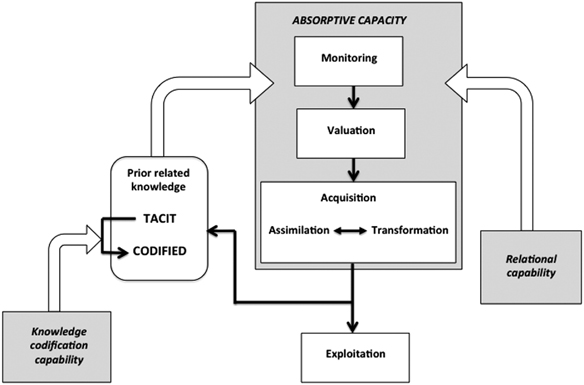
Absorptive capacity and knowledge management in small and medium enterprises
This article is part of a series looking at knowledge management (KM) in small and medium enterprises (SMEs).
A new study1 on the topic of knowledge management in small and medium enterprises (SMEs) explores the research gap in regard to the role of relationships in SME knowledge management processes. With the aim of filling this gap, a framework focusing on the concept of absorptive capacity is proposed. Based on the proposed framework, two specific topics of considerable importance to SMEs are discussed: how capabilities are developed in the start-up phase of a new venture, and knowledge processes in geographical clusters.
The most important aspect distinguishing small and medium enterprises (SMEs) from large firms has been found to be their ability to exploit relationships developed outside the firm, which enables them to overcome the constraints that come from their limited size. Knowledge management studies have similarly led to a realisation that it is fundamentally important for SMEs to be able to exploit external sources of knowledge.
However, literature reviews conducted on knowledge management in SMEs reveal that the understanding of knowledge management and relationships in SMEs is not enough to give a whole, detailed picture of this connection, and to clearly bring out the differences between SMEs and larger-scale enterprises.
The absorptive capacity concept is proposed as a way of clarifying the difference between SMEs and larger enterprises from a knowledge management point of view.
For the purposes of the study, absorptive capacity was considered as including the processes of monitoring, evaluating, and acquiring or committing to memory external knowledge. Taken as a whole, these processes rely on a firm’s prior related knowledge (both tacit and codified), and on its relational capability. Knowledge can be absorbed in a codification-driven manner, or interaction-driven, or a ‘hybrid’ of the codification-driven and interaction-driven forms in which relationships serve as a vehicle for absorbing codified knowledge.

A model of absorptive capacity
Interaction-driven absorption is important in a firm’s start-up phase, when social capital is exploited to mitigate the knowledge gaps that firms frequently experience at commencement. After this, however, SMEs typically codify knowledge in only a limited way, which prevents them from adequately exploring useful knowledge sources to defend their competitive position and permanently exposes them to the risk of knowledge loss. In many geographical clusters, signs of cognitive lock-in have even been observed, which is similar to the way in which consumers always purchase products under the same brand name, never exploring alternative options.
Taking the proposed approach to absorptive capacity reveals an important research question: How can SMEs develop an adequate knowledge codification capability in alternative ways to those of large enterprises? Research findings support endeavours in this line of research.
Reference:
- Grandinetti, R. (2016) Absorptive capacity and knowledge management in small and medium enterprises, Knowledge Management Research & Practice 14(2), 159–168. doi:10.1057/kmrp.2016.2 ↩
Also published on Medium.





